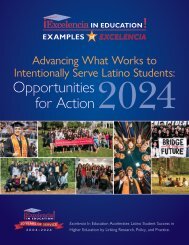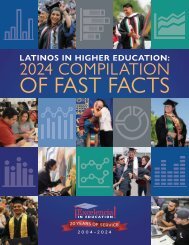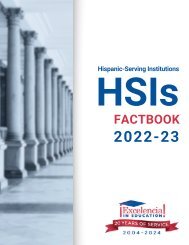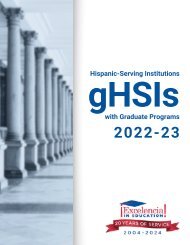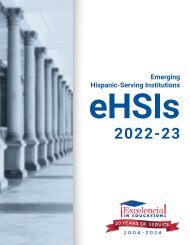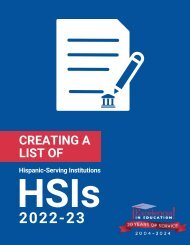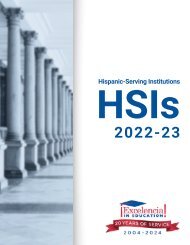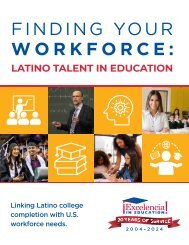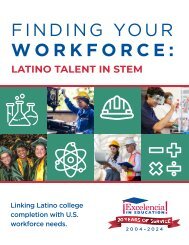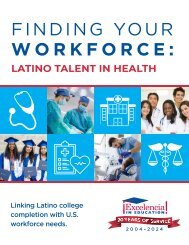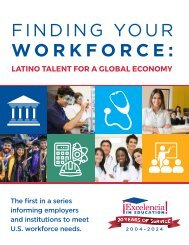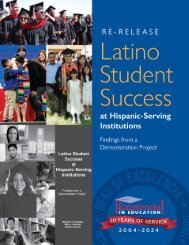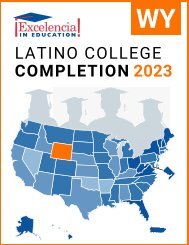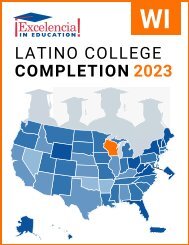Latino College Completion 2023: Indiana
Create successful ePaper yourself
Turn your PDF publications into a flip-book with our unique Google optimized e-Paper software.
IN
LATINO COLLEGE COMPLETION:<br />
INDIANA – <strong>2023</strong><br />
For the U.S. to regain the top ranking in the world for college degree<br />
attainment, <strong>Latino</strong>s will need to earn 6.2 million degrees by 2030. 1<br />
FAST FACTS<br />
STATE RANKING:<br />
<strong>Indiana</strong> had the 21st largest<br />
<strong>Latino</strong> population in the U.S.<br />
K-12 POPULATION:<br />
In <strong>Indiana</strong>, 12% of the K-12<br />
population was <strong>Latino</strong>. 2<br />
POPULATION:<br />
In <strong>Indiana</strong>, 8% of the population was<br />
<strong>Latino</strong>. 2<br />
MEDIAN AGE:<br />
The median age<br />
of Hispanics in<br />
<strong>Indiana</strong> was 25,<br />
compared to 41<br />
for White non-<br />
Hispanics. 2<br />
25<br />
Hispanics<br />
41<br />
White<br />
non-Hispanics<br />
ENROLLMENT:<br />
In <strong>Indiana</strong>, 18% of Hispanics<br />
(ages 18 to 34) were enrolled in<br />
higher education, compared to 21%<br />
of White non-Hispanics. 2<br />
DEGREE ATTAINMENT:<br />
In <strong>Indiana</strong>, 26% of Hispanic<br />
adults (25 and older) had earned an<br />
associate degree or higher, compared to<br />
39% of White non-Hispanic adults. 2<br />
Hispanic Adults = 2.6 of 10<br />
To reach the degree attainment goal by 2030, the U.S. can: close<br />
the degree completion gap by accelerating <strong>Latino</strong> completion while<br />
increasing for all students and scale up programs and initiatives that<br />
work for <strong>Latino</strong>, and all, students. The following demographics,<br />
institutional data, and practices inform <strong>Latino</strong> degree attainment.<br />
ENROLLING: Top 5 Institutions (Hispanic Undergraduates) in <strong>Indiana</strong>, 2021-22<br />
Institution<br />
Sector<br />
Grand<br />
Total<br />
NOTE: We use the terms <strong>Latino</strong> and Hispanic interchangeably in this factsheet.<br />
Hispanic<br />
Total<br />
Source: Excelencia in Education analysis using U.S. Department of Education, National Center for<br />
Education Statistics (NCES), Integrated Postsecondary Education Data System (IPEDS), 2021 Fall<br />
Enrollment, Graduation Rates Survey and Institutional Characteristics Survey.<br />
%<br />
Hispanic<br />
1 Purdue University Global Public, 4-year 32,213 4,650 14%<br />
2 <strong>Indiana</strong> University-Bloomington Public, 4-year 33,995 2,693 8%<br />
3 Ivy Tech Community <strong>College</strong> Public, 2-year 51,522 2,440 5%<br />
4 Purdue University-Main Campus Public, 4-year 37,658 2,355 6%<br />
<strong>Indiana</strong> University-Purdue University-<br />
5 <strong>Indiana</strong>polis<br />
Public, 4-year 18,707 2,195 12%<br />
ASSOCIATE DEGREES: Top 5 Institutions Awarding to Hispanics in <strong>Indiana</strong>, 2020-21<br />
Institution<br />
Sector<br />
Grand<br />
Total<br />
Hispanic<br />
Total<br />
%<br />
Hispanic<br />
1 Purdue University Global Public, 4-year 1,985 323 16%<br />
2 Ivy Tech Community <strong>College</strong> Public, 2-year 8,664 322 4%<br />
3 Vincennes University Public, 4-year 1,404 179 13%<br />
<strong>Indiana</strong> Wesleyan University-National & Private not-forprofit,<br />
4-year<br />
4 Global<br />
544 23 4%<br />
5<br />
International Business <strong>College</strong>-<br />
<strong>Indiana</strong>polis<br />
Private forprofit,<br />
2-year<br />
152 16 11%<br />
BACHELOR DEGREES: Top 5 Institutions Awarding to Hispanics in <strong>Indiana</strong>, 2020-21<br />
Institution<br />
Sector<br />
Grand<br />
Total<br />
Hispanic<br />
Total<br />
%<br />
Hispanic<br />
1 Purdue University Global Public, 4-year 4,943 575 12%<br />
2 <strong>Indiana</strong> University-Bloomington Public, 4-year 7,495 502 7%<br />
3 Purdue University-Main Campus Public, 4-year 7,591 392 5%<br />
<strong>Indiana</strong> University-Purdue University-<br />
4 <strong>Indiana</strong>polis<br />
Public, 4-year 4,427 334 8%<br />
5 Purdue University Northwest Public, 4-year 1,624 323 20%<br />
White Adults = 3.9 of 10<br />
1 Projections to 2030: Excelencia in Education. (2020). Ensuring America’s Future: Benchmarking <strong>Latino</strong><br />
<strong>College</strong> <strong>Completion</strong> to 2030. Excelencia in Education. Washington, D.C.<br />
2 U.S. Census Bureau, 2021 American Community Survey 1-Year Estimates
<strong>Indiana</strong> Gap in Degree <strong>Completion</strong><br />
Closing the degree completion gap can be tracked<br />
by the 4 measures shown below. Alone, none<br />
of these measures capture the entire “story” of<br />
degree completion. However, in combination,<br />
they provide a useful picture of the gap in degree<br />
attainment between Hispanic and White non-<br />
Hispanic cohorts in a single year.<br />
Graduation Rate — Total percentage of students<br />
who graduated within 150% of normal time for<br />
first-time, full-time freshmen. This incorporates<br />
students that graduated in 3 years at two-year<br />
institutions, or in 6 years at four-year institutions.<br />
Transferred to Another Institution —<br />
Percentage of students that transferred to another<br />
institution and did not complete a degree.<br />
Still Enrolled — Percentage of students that are<br />
still enrolled at the point of 150% normal time to<br />
completion.<br />
No Longer Enrolled — Percentage of students<br />
that are no longer enrolled at the point of 150%<br />
normal time to completion.<br />
At two-year institutions, Hispanics’<br />
graduation rate was 2%-points<br />
higher than that of their White<br />
non-Hispanic peers in <strong>Indiana</strong>.<br />
TWO-YEAR INSTITUTIONS<br />
47%<br />
36%<br />
WHITE<br />
48%<br />
9% 8%<br />
9%<br />
6%<br />
+2%<br />
38%<br />
HISPANIC<br />
DEGREE OUTCOMES<br />
■ No Longer Enrolled<br />
■ Still Enrolled<br />
■ Transferred to<br />
Another Institution<br />
■ Graduation Rate<br />
*Percentages may not add up to 100% due to rounding.<br />
At four-year institutions, Hispanics’<br />
graduation rate was 9%-points<br />
lower than that of their White<br />
non-Hispanic peers in <strong>Indiana</strong>.<br />
FOUR-YEAR INSTITUTIONS<br />
1%<br />
22%<br />
11%<br />
67%<br />
WHITE<br />
2%<br />
-9%<br />
29%<br />
11%<br />
58%<br />
HISPANIC<br />
NOTE: Outcomes shown are for students at two-year institutions who started in Fall 2018, and<br />
for students at four-year institutions who started in Fall 2015.<br />
Source: Excelencia in Education analysis using the U.S. Department of Education, National<br />
Center for Education Statistics (NCES), Integrated Postsecondary Education Data System, 2021<br />
Graduation Rates Survey and the Institutional Characteristics Survey.<br />
Examples of What Works for <strong>Latino</strong> Students<br />
There are institutions showing success in enrolling, retaining, and graduating <strong>Latino</strong> students. The following are examples of<br />
programs across the country with evidence of effectiveness in serving <strong>Latino</strong> students nominated for Examples of Excelencia.<br />
The objective of Community Education Coalition’s TuFuturo was to<br />
develop a learning system which would ensure each student (with support<br />
from their parents) is ready for the next step in their education pathway.<br />
Our mission is to support the <strong>Latino</strong> community to improve their lives<br />
through education. Support is provided from Pre-K through community<br />
college and/or baccalaureate degree attainment. The primary goals are to<br />
co-create solutions to eliminate <strong>Latino</strong> education achievement gaps, align<br />
<strong>Latino</strong> education programming, and create a network for information<br />
sharing. Since 2011, TuFuturo has implemented a number of strategies to<br />
improve educational outcomes for our <strong>Latino</strong> community. Services are<br />
provided to the youngest children and their parents as a gateway to the<br />
rest of the educational system and college and career readiness support<br />
is provided through workshops from middle school through college for<br />
<strong>Latino</strong> students and families.<br />
Latinx high school graduation rates have increased from 64% in 2007 to<br />
83% in 2021. The equity gap for high school graduation rates between<br />
Latinx and all students was reduced from 17.6% in 2007 to 1.9% in 2021.<br />
The percentage of Latinx students who transition to postsecondary<br />
education increased by 13%. In 2011 just 39% of the Latinx high school<br />
graduates enrolled in postsecondary education but by 2019 this increased<br />
to 52% enrolled in postsecondary education.<br />
For more information on institutional programs improving <strong>Latino</strong> student success in higher education, access Excelencia in<br />
Education’s Growing What Works database at http://www.edexcelencia.org/growing-what-works<br />
ENSURING AMERICA’S FUTURE BY INCREASING LATINO COLLEGE COMPLETION • WWW.EDEXCELENCIA.ORG




